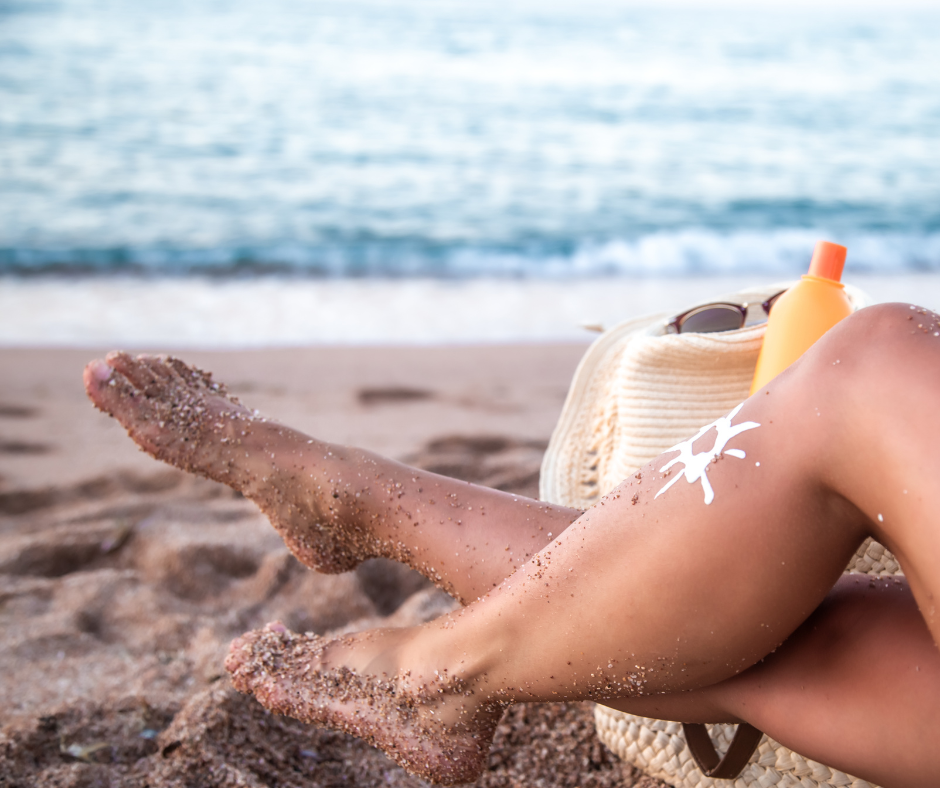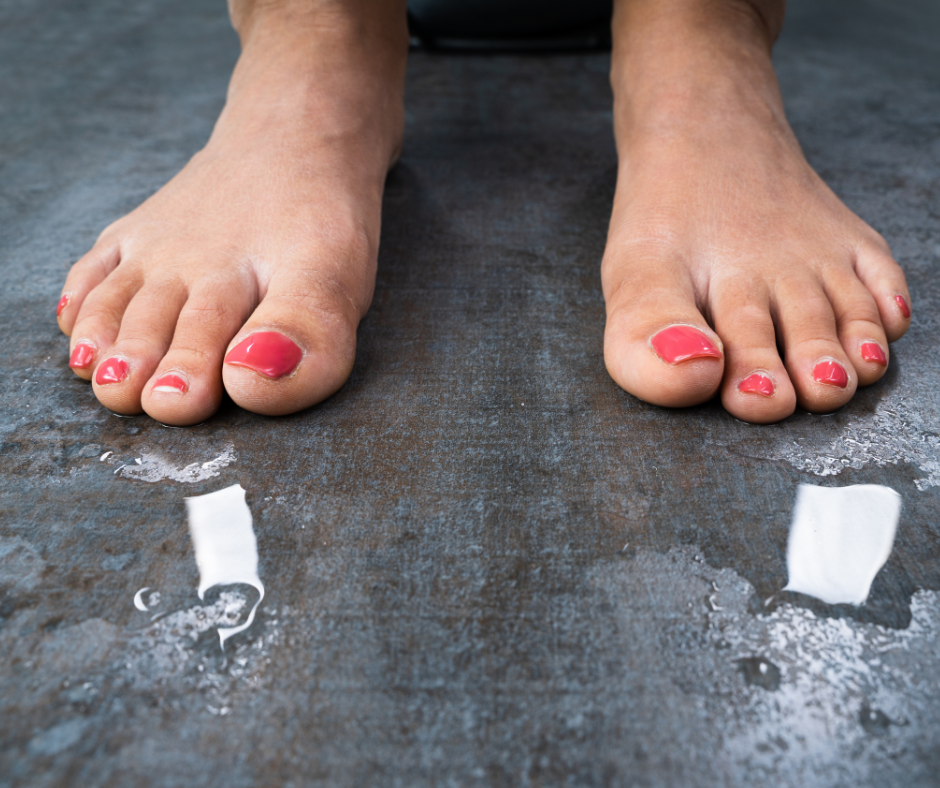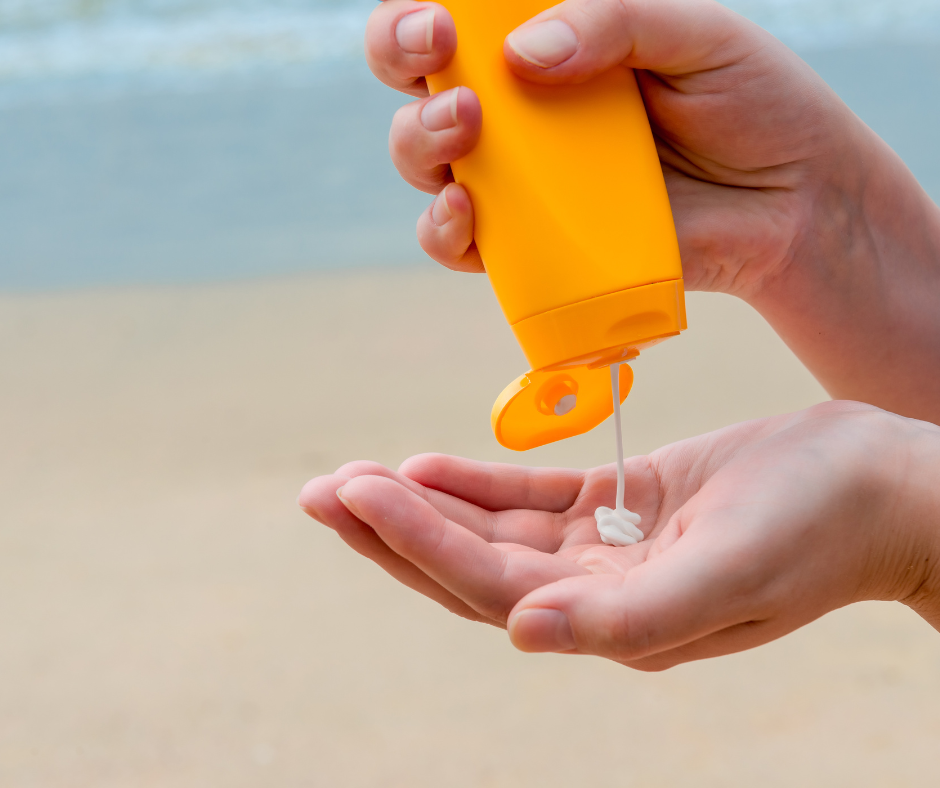-
Protect Your Feet from the Summer Sun

Just like the rest of your body, your feet are susceptible to sun damage. UV rays penetrate the layers of your skin, causing sunburn, premature aging, and increasing the risk of cancer. While the soles of your feet have thicker skin, the tops and ankles are vulnerable, especially for people who wear sandals or flip-flops regularly.
If we diligently protect our faces and arms with sunscreen, why should we neglect our feet? Here’s why you shouldn’t forget about protecting them from the sun’s harmful UV rays, according to our expert team at Kentlands Foot and Ankle Center.
The Risks of Sun-Exposed Feet
- Actinic Keratosis: These precancerous lesions appear as rough, scaly patches on skin exposed to the sun, especially during summer. While not cancerous themselves, they can develop into skin cancer if left untreated.
- Squamous Cell Carcinoma: This is a type of skin cancer that can develop on the sensitive areas of the feet. Early detection can decrease the risk of complications, so be aware of any changes in the appearance of your skin, such as new moles, persistent scaling, or bleeding.
- Age spots: These are flat, brown spots that commonly appear on sun-exposed areas, including the tops of the feet. While benign, they can be a cosmetic concern for some.
- Pre-existing skin conditions: Sun exposure can worsen existing skin conditions on the feet, such as eczema or psoriasis, leading to increased itching, inflammation, and discomfort.
Protecting Your Feet This Summer
- Sunscreen: Apply broad-spectrum sunscreen with SPF 30 or higher to the tops of your feet and ankles 15 minutes before sun exposure. Reapply every two hours, especially after swimming or sweating.
- Sun-Protective Footwear: Wear closed-toe shoes or sandals with straps that cover the tops of your feet. Look for materials like canvas or mesh that allow for ventilation while providing some sun protection.
- Examine Your Feet Regularly: Pay attention to any changes in the appearance of your skin, such as new moles, discolored spots, or changes in texture. If you notice anything concerning, consult a podiatrist.
Want to keep your feet happy and healthy this summer? We’re eager to help! Schedule a comprehensive foot examination with Kentlands Foot and Ankle Center podiatrist Dr. Jon M. Sherman. To schedule your appointment, please contact our office at 301-825-9697.
-
Beat the Sweat: How BOTOX® Can Help with Hyperhidrosis

Sometimes, your body’s typical processes can go askew, leading normal actions like sweating or walking to become significantly more complicated in the worst of ways. Sweating, for example, plays a vital role in regulating body temperature. But for some, sweating goes beyond keeping cool and becomes a daily struggle known as hyperhidrosis.
Kentlands Foot & Ankle Center has put together a quick blog on the subject to help you stay cool and dry through the summer months. Read on to learn how you can handle excessive sweat with a few podiatric pointers courtesy of our expert team.
The Impact of Excessive Sweating
The constant fear of visible sweat can lead to social withdrawal and increased stress. Beyond social anxieties, excessive sweating can also have physical consequences:
- Cold and clammy skin: This can make movement uncomfortable while increasing your risk of calluses, blisters, or corns, which are serious problems for diabetics in particular. Clammy skin can also limit shoe choice.
- Smelly feet: This can be embarrassing and lead to self-consciousness, which in turn might make some affected individuals less physically active or socially outgoing.
- Dehydration: Excessive sweating can deplete electrolytes and fluids, leading to dehydration.
- Skin infections: Constant moisture can create an environment ripe for bacterial growth, increasing the risk of infections.
- Ruined clothes and shoes: Clothing or footwear made unusable due to excessive sweat can be a costly burden.
BOTOX® to the Rescue
Thankfully, those affected by excessive sweat have access to a proven solution.
- BOTOX®, known for its use in wrinkle reduction, can also be a game-changer for hyperhidrosis affecting the feet.
- It works by temporarily blocking nerve signals that trigger sweat glands in the targeted area.
- This leads to a significant reduction in sweat production, providing much-needed relief.
Taking Control of Your Sweat and Comfort
Hyperhidrosis and painful feet shouldn’t hold you back, but if it’s neglected for too long, you might find yourself with a persistent fungal infection, damaged skin, or worse. With BOTOX treatments for excessive sweating, you can regain confidence and comfort in your daily life.
Interested in learning more? We’re always happy to help! Schedule a comprehensive foot examination with Kentlands Foot and Ankle Center podiatrist Dr. Jon M. Sherman. To make your appointment, please call our office at 301-825-9697.
-
UV Safety Awareness Month

Summer is finally here! The great outdoors is beckoning. Many people tend to forget that their feet and ankles are just as vulnerable to harmful UV rays as the rest of their bodies. Sunlight is a potent source of ultraviolet radiation. Overexposure to the sun can cause a host of serious health issues such as skin cancer, heat exhaustion, and melanoma. At Kentlands Foot and Ankle Center, we want all our patients to feel safe and protected while still enjoying their favorite summer activities! Below you will find signs of skin cancer and tips and tricks to protect your feet from damaging UV rays.
Learn to recognize the signs of skin cancer. A helpful way to remember the signs of skin cancer is ABCDE:
- A is for asymmetry. Most moles are symmetrical. If you find a mole that is not symmetrical, bring it to your doctor’s attention.
- B is for borders. Be alert to a new or changed mole with irregular borders.
- C is for color. If you spot a mole with an unusual color, get it checked.
- D is for diameter. Any mole larger than the eraser on the tip of a pencil should be considered suspect.
- E is for evolving. Healthy moles don’t change.
How To Protect Your Feet from Damaging UV Rays
- Always Apply Sunscreen. Most dermatologists recommend using sunscreen with an SPF of at least 30. This will protect your skin from 97% of the sun’s harmful UV radiation.
- Wear Shoes That Protect Your Feet. Flip-Flops and sandals are a summer favorite. But they are not the best choice for protecting your feet from the elements. Shoes such as Crocs can protect your feet while also allowing your feet to breathe. Plus, they are waterproof!
- Cover Your Skin. Get settled under a tree or canopy. Alternatively, use breathable fabrics to keep you cool and protected from the sun!
- Avoid Peak Sun-Times. In most places, the sun is usually the strongest from 10 am to 4 pm. If you are outside during these times, take precautionary measures and incorporate all our tips.
- Drink Plenty of Water every day. Remembering to stay hydrated is especially important in the summer sun. The U.S. National Academies of Sciences, Engineering, and Medicine determined that an adequate daily fluid intake to replenish your body is: About 15.5 cups (3.7 liters) of fluids a day for men. About 11.5 cups (2.7 liters) of fluids a day for women. When perspiring, drink even more water.
Board-certified podiatrist Dr. Jon M. Sherman uses advanced technology and can treat a wide range of patients. To schedule an appointment, please call our Montgomery County office at 301-330-5666 or visit our website for more information.
RECENT POSTS
categories
- Uncategorized
- Featured Articles
- Foot Disorders
- Broken Ankle
- Broken Toe
- Fracture
- Foot Health
- Foot Care
- Arthritis
- Foot Pain
- Skin Cancer
- Podiatry Appointment
- Custom Orthotics
- Podiatrist
- Diabetes
- Gout
- Heart Health
- National Nutrition Month
- National Foot Health Awareness Month
- Foot Safety
- Foot and Ankle Injuries
- Falls Prevention
- Chronic Heel Pain
- Shoes
- Laser Therapy
- Quoted
- Physical Therapy
- KeryFlex
- Sweat
- Summer Foot Care
- Sports Injury
- ESWT
- Fungal Toenails
- Bunion
- Plantar Fasciitis
- PinPointe Laser
- Heel Pain


